Organisational Behaviour Theories and Employee Performance Analysis
VerifiedAdded on 2020/05/28
|8
|2473
|46
Report
AI Summary
This report provides a comprehensive analysis of organisational behaviour theories and their application in improving employee productive performance. It begins by defining organisational behaviour and highlighting the crucial role of leadership in influencing employee performance through various factors like job design, goal setting, and motivation. The report delves into specific theories, including Herzberg's Two Factor Theory, Job Characteristics Model, Culture Theory, and Personality-Job Fit theory, illustrating how they can be strategically implemented to enhance employee satisfaction and productivity. Furthermore, it examines the importance of motivation, discussing Maslow's Hierarchy of Needs and goal-setting theory. The report also explores the Human Relations Approach and the Scientific Leadership Approach, emphasizing the need for managers to adapt their strategies based on the changing market conditions. Ultimately, the report emphasizes the significance of aligning organisational practices with ethical considerations and social responsibilities to foster sustained growth and development within the organisation. The report uses examples from companies like Tesco, Apple, Google, Microsoft and Facebook to support the theories.
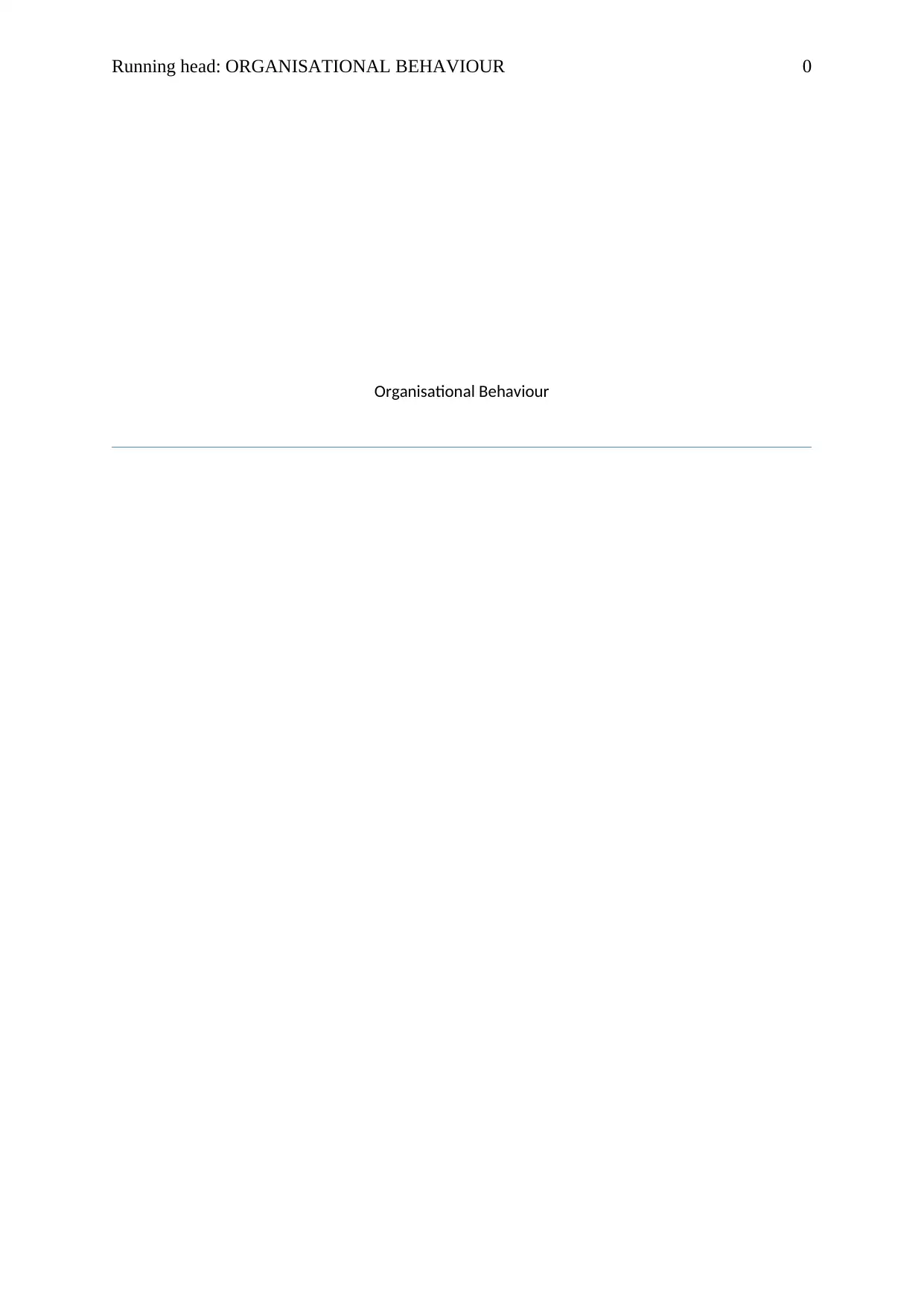
Running head: ORGANISATIONAL BEHAVIOUR 0
Organisational Behaviour
Organisational Behaviour
Paraphrase This Document
Need a fresh take? Get an instant paraphrase of this document with our AI Paraphraser
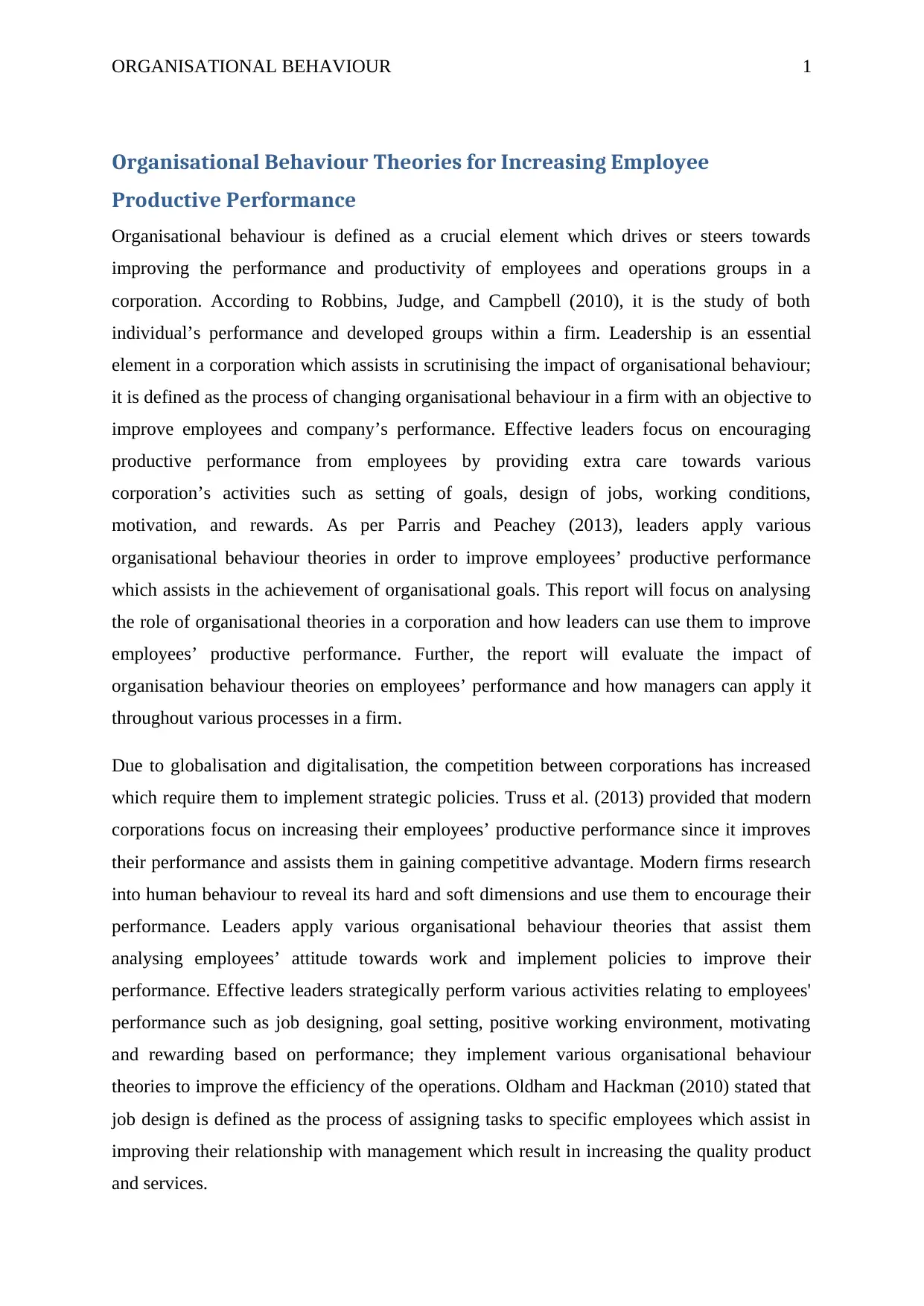
ORGANISATIONAL BEHAVIOUR 1
Organisational Behaviour Theories for Increasing Employee
Productive Performance
Organisational behaviour is defined as a crucial element which drives or steers towards
improving the performance and productivity of employees and operations groups in a
corporation. According to Robbins, Judge, and Campbell (2010), it is the study of both
individual’s performance and developed groups within a firm. Leadership is an essential
element in a corporation which assists in scrutinising the impact of organisational behaviour;
it is defined as the process of changing organisational behaviour in a firm with an objective to
improve employees and company’s performance. Effective leaders focus on encouraging
productive performance from employees by providing extra care towards various
corporation’s activities such as setting of goals, design of jobs, working conditions,
motivation, and rewards. As per Parris and Peachey (2013), leaders apply various
organisational behaviour theories in order to improve employees’ productive performance
which assists in the achievement of organisational goals. This report will focus on analysing
the role of organisational theories in a corporation and how leaders can use them to improve
employees’ productive performance. Further, the report will evaluate the impact of
organisation behaviour theories on employees’ performance and how managers can apply it
throughout various processes in a firm.
Due to globalisation and digitalisation, the competition between corporations has increased
which require them to implement strategic policies. Truss et al. (2013) provided that modern
corporations focus on increasing their employees’ productive performance since it improves
their performance and assists them in gaining competitive advantage. Modern firms research
into human behaviour to reveal its hard and soft dimensions and use them to encourage their
performance. Leaders apply various organisational behaviour theories that assist them
analysing employees’ attitude towards work and implement policies to improve their
performance. Effective leaders strategically perform various activities relating to employees'
performance such as job designing, goal setting, positive working environment, motivating
and rewarding based on performance; they implement various organisational behaviour
theories to improve the efficiency of the operations. Oldham and Hackman (2010) stated that
job design is defined as the process of assigning tasks to specific employees which assist in
improving their relationship with management which result in increasing the quality product
and services.
Organisational Behaviour Theories for Increasing Employee
Productive Performance
Organisational behaviour is defined as a crucial element which drives or steers towards
improving the performance and productivity of employees and operations groups in a
corporation. According to Robbins, Judge, and Campbell (2010), it is the study of both
individual’s performance and developed groups within a firm. Leadership is an essential
element in a corporation which assists in scrutinising the impact of organisational behaviour;
it is defined as the process of changing organisational behaviour in a firm with an objective to
improve employees and company’s performance. Effective leaders focus on encouraging
productive performance from employees by providing extra care towards various
corporation’s activities such as setting of goals, design of jobs, working conditions,
motivation, and rewards. As per Parris and Peachey (2013), leaders apply various
organisational behaviour theories in order to improve employees’ productive performance
which assists in the achievement of organisational goals. This report will focus on analysing
the role of organisational theories in a corporation and how leaders can use them to improve
employees’ productive performance. Further, the report will evaluate the impact of
organisation behaviour theories on employees’ performance and how managers can apply it
throughout various processes in a firm.
Due to globalisation and digitalisation, the competition between corporations has increased
which require them to implement strategic policies. Truss et al. (2013) provided that modern
corporations focus on increasing their employees’ productive performance since it improves
their performance and assists them in gaining competitive advantage. Modern firms research
into human behaviour to reveal its hard and soft dimensions and use them to encourage their
performance. Leaders apply various organisational behaviour theories that assist them
analysing employees’ attitude towards work and implement policies to improve their
performance. Effective leaders strategically perform various activities relating to employees'
performance such as job designing, goal setting, positive working environment, motivating
and rewarding based on performance; they implement various organisational behaviour
theories to improve the efficiency of the operations. Oldham and Hackman (2010) stated that
job design is defined as the process of assigning tasks to specific employees which assist in
improving their relationship with management which result in increasing the quality product
and services.
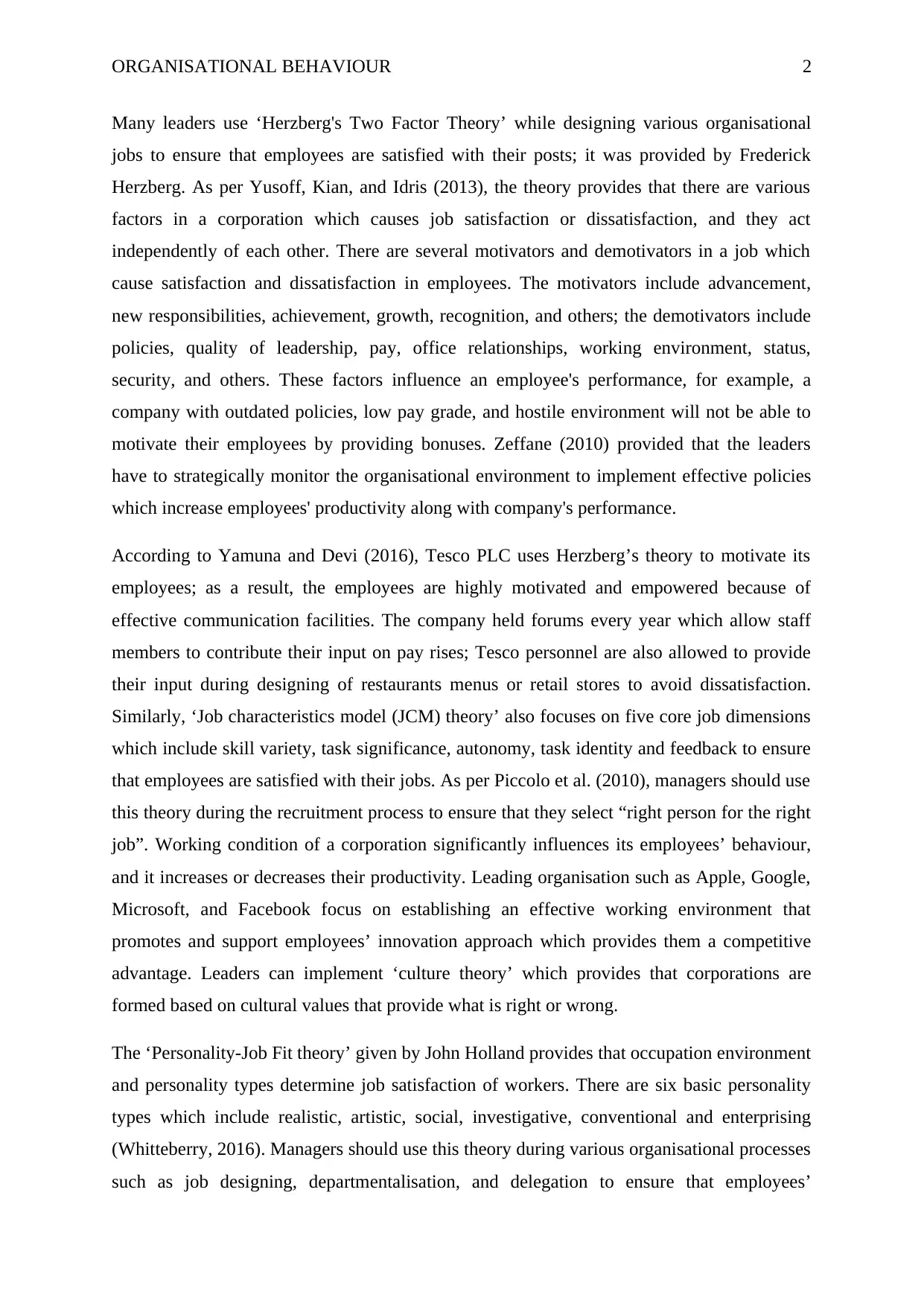
ORGANISATIONAL BEHAVIOUR 2
Many leaders use ‘Herzberg's Two Factor Theory’ while designing various organisational
jobs to ensure that employees are satisfied with their posts; it was provided by Frederick
Herzberg. As per Yusoff, Kian, and Idris (2013), the theory provides that there are various
factors in a corporation which causes job satisfaction or dissatisfaction, and they act
independently of each other. There are several motivators and demotivators in a job which
cause satisfaction and dissatisfaction in employees. The motivators include advancement,
new responsibilities, achievement, growth, recognition, and others; the demotivators include
policies, quality of leadership, pay, office relationships, working environment, status,
security, and others. These factors influence an employee's performance, for example, a
company with outdated policies, low pay grade, and hostile environment will not be able to
motivate their employees by providing bonuses. Zeffane (2010) provided that the leaders
have to strategically monitor the organisational environment to implement effective policies
which increase employees' productivity along with company's performance.
According to Yamuna and Devi (2016), Tesco PLC uses Herzberg’s theory to motivate its
employees; as a result, the employees are highly motivated and empowered because of
effective communication facilities. The company held forums every year which allow staff
members to contribute their input on pay rises; Tesco personnel are also allowed to provide
their input during designing of restaurants menus or retail stores to avoid dissatisfaction.
Similarly, ‘Job characteristics model (JCM) theory’ also focuses on five core job dimensions
which include skill variety, task significance, autonomy, task identity and feedback to ensure
that employees are satisfied with their jobs. As per Piccolo et al. (2010), managers should use
this theory during the recruitment process to ensure that they select “right person for the right
job”. Working condition of a corporation significantly influences its employees’ behaviour,
and it increases or decreases their productivity. Leading organisation such as Apple, Google,
Microsoft, and Facebook focus on establishing an effective working environment that
promotes and support employees’ innovation approach which provides them a competitive
advantage. Leaders can implement ‘culture theory’ which provides that corporations are
formed based on cultural values that provide what is right or wrong.
The ‘Personality-Job Fit theory’ given by John Holland provides that occupation environment
and personality types determine job satisfaction of workers. There are six basic personality
types which include realistic, artistic, social, investigative, conventional and enterprising
(Whitteberry, 2016). Managers should use this theory during various organisational processes
such as job designing, departmentalisation, and delegation to ensure that employees’
Many leaders use ‘Herzberg's Two Factor Theory’ while designing various organisational
jobs to ensure that employees are satisfied with their posts; it was provided by Frederick
Herzberg. As per Yusoff, Kian, and Idris (2013), the theory provides that there are various
factors in a corporation which causes job satisfaction or dissatisfaction, and they act
independently of each other. There are several motivators and demotivators in a job which
cause satisfaction and dissatisfaction in employees. The motivators include advancement,
new responsibilities, achievement, growth, recognition, and others; the demotivators include
policies, quality of leadership, pay, office relationships, working environment, status,
security, and others. These factors influence an employee's performance, for example, a
company with outdated policies, low pay grade, and hostile environment will not be able to
motivate their employees by providing bonuses. Zeffane (2010) provided that the leaders
have to strategically monitor the organisational environment to implement effective policies
which increase employees' productivity along with company's performance.
According to Yamuna and Devi (2016), Tesco PLC uses Herzberg’s theory to motivate its
employees; as a result, the employees are highly motivated and empowered because of
effective communication facilities. The company held forums every year which allow staff
members to contribute their input on pay rises; Tesco personnel are also allowed to provide
their input during designing of restaurants menus or retail stores to avoid dissatisfaction.
Similarly, ‘Job characteristics model (JCM) theory’ also focuses on five core job dimensions
which include skill variety, task significance, autonomy, task identity and feedback to ensure
that employees are satisfied with their jobs. As per Piccolo et al. (2010), managers should use
this theory during the recruitment process to ensure that they select “right person for the right
job”. Working condition of a corporation significantly influences its employees’ behaviour,
and it increases or decreases their productivity. Leading organisation such as Apple, Google,
Microsoft, and Facebook focus on establishing an effective working environment that
promotes and support employees’ innovation approach which provides them a competitive
advantage. Leaders can implement ‘culture theory’ which provides that corporations are
formed based on cultural values that provide what is right or wrong.
The ‘Personality-Job Fit theory’ given by John Holland provides that occupation environment
and personality types determine job satisfaction of workers. There are six basic personality
types which include realistic, artistic, social, investigative, conventional and enterprising
(Whitteberry, 2016). Managers should use this theory during various organisational processes
such as job designing, departmentalisation, and delegation to ensure that employees’
⊘ This is a preview!⊘
Do you want full access?
Subscribe today to unlock all pages.

Trusted by 1+ million students worldwide
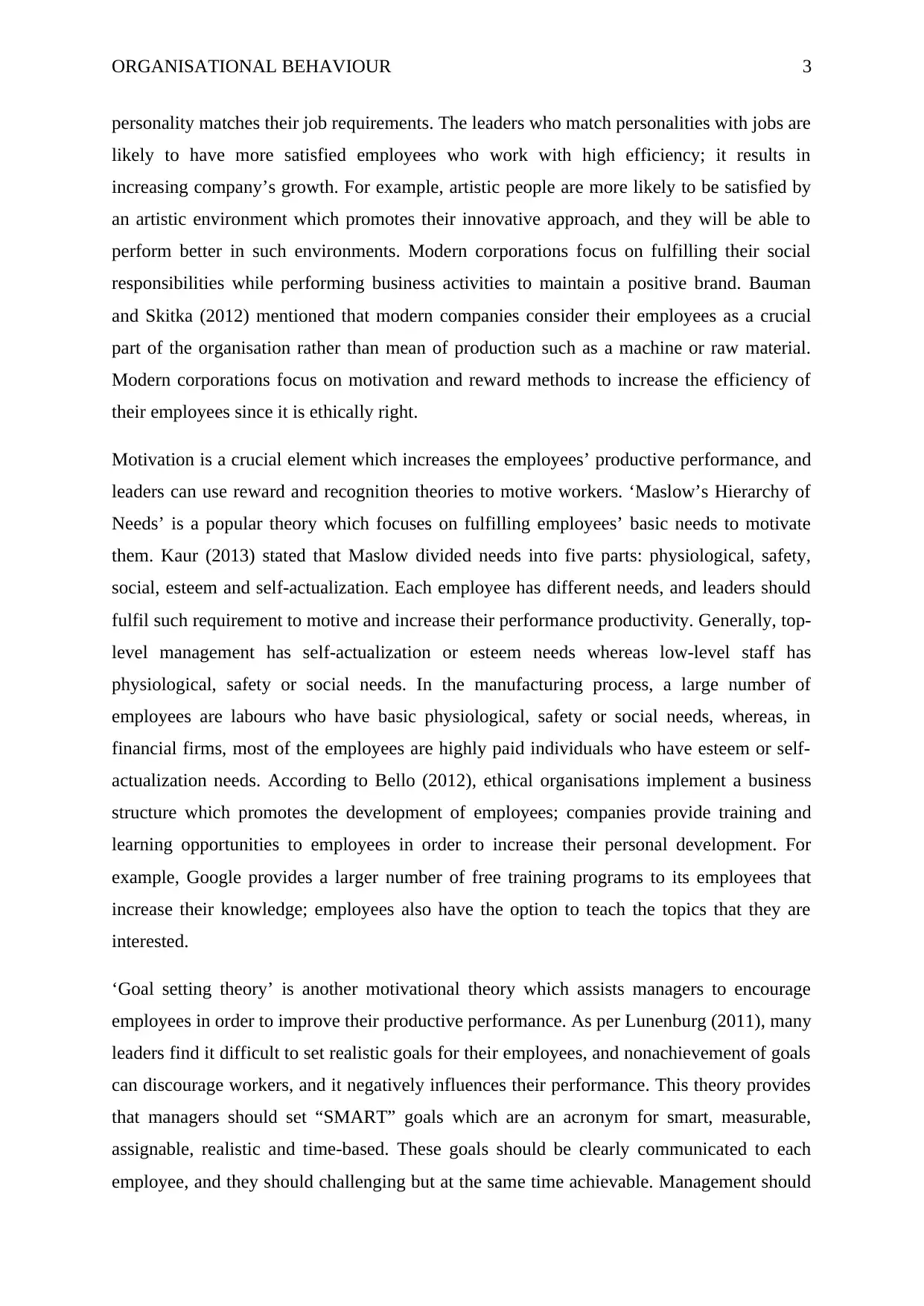
ORGANISATIONAL BEHAVIOUR 3
personality matches their job requirements. The leaders who match personalities with jobs are
likely to have more satisfied employees who work with high efficiency; it results in
increasing company’s growth. For example, artistic people are more likely to be satisfied by
an artistic environment which promotes their innovative approach, and they will be able to
perform better in such environments. Modern corporations focus on fulfilling their social
responsibilities while performing business activities to maintain a positive brand. Bauman
and Skitka (2012) mentioned that modern companies consider their employees as a crucial
part of the organisation rather than mean of production such as a machine or raw material.
Modern corporations focus on motivation and reward methods to increase the efficiency of
their employees since it is ethically right.
Motivation is a crucial element which increases the employees’ productive performance, and
leaders can use reward and recognition theories to motive workers. ‘Maslow’s Hierarchy of
Needs’ is a popular theory which focuses on fulfilling employees’ basic needs to motivate
them. Kaur (2013) stated that Maslow divided needs into five parts: physiological, safety,
social, esteem and self-actualization. Each employee has different needs, and leaders should
fulfil such requirement to motive and increase their performance productivity. Generally, top-
level management has self-actualization or esteem needs whereas low-level staff has
physiological, safety or social needs. In the manufacturing process, a large number of
employees are labours who have basic physiological, safety or social needs, whereas, in
financial firms, most of the employees are highly paid individuals who have esteem or self-
actualization needs. According to Bello (2012), ethical organisations implement a business
structure which promotes the development of employees; companies provide training and
learning opportunities to employees in order to increase their personal development. For
example, Google provides a larger number of free training programs to its employees that
increase their knowledge; employees also have the option to teach the topics that they are
interested.
‘Goal setting theory’ is another motivational theory which assists managers to encourage
employees in order to improve their productive performance. As per Lunenburg (2011), many
leaders find it difficult to set realistic goals for their employees, and nonachievement of goals
can discourage workers, and it negatively influences their performance. This theory provides
that managers should set “SMART” goals which are an acronym for smart, measurable,
assignable, realistic and time-based. These goals should be clearly communicated to each
employee, and they should challenging but at the same time achievable. Management should
personality matches their job requirements. The leaders who match personalities with jobs are
likely to have more satisfied employees who work with high efficiency; it results in
increasing company’s growth. For example, artistic people are more likely to be satisfied by
an artistic environment which promotes their innovative approach, and they will be able to
perform better in such environments. Modern corporations focus on fulfilling their social
responsibilities while performing business activities to maintain a positive brand. Bauman
and Skitka (2012) mentioned that modern companies consider their employees as a crucial
part of the organisation rather than mean of production such as a machine or raw material.
Modern corporations focus on motivation and reward methods to increase the efficiency of
their employees since it is ethically right.
Motivation is a crucial element which increases the employees’ productive performance, and
leaders can use reward and recognition theories to motive workers. ‘Maslow’s Hierarchy of
Needs’ is a popular theory which focuses on fulfilling employees’ basic needs to motivate
them. Kaur (2013) stated that Maslow divided needs into five parts: physiological, safety,
social, esteem and self-actualization. Each employee has different needs, and leaders should
fulfil such requirement to motive and increase their performance productivity. Generally, top-
level management has self-actualization or esteem needs whereas low-level staff has
physiological, safety or social needs. In the manufacturing process, a large number of
employees are labours who have basic physiological, safety or social needs, whereas, in
financial firms, most of the employees are highly paid individuals who have esteem or self-
actualization needs. According to Bello (2012), ethical organisations implement a business
structure which promotes the development of employees; companies provide training and
learning opportunities to employees in order to increase their personal development. For
example, Google provides a larger number of free training programs to its employees that
increase their knowledge; employees also have the option to teach the topics that they are
interested.
‘Goal setting theory’ is another motivational theory which assists managers to encourage
employees in order to improve their productive performance. As per Lunenburg (2011), many
leaders find it difficult to set realistic goals for their employees, and nonachievement of goals
can discourage workers, and it negatively influences their performance. This theory provides
that managers should set “SMART” goals which are an acronym for smart, measurable,
assignable, realistic and time-based. These goals should be clearly communicated to each
employee, and they should challenging but at the same time achievable. Management should
Paraphrase This Document
Need a fresh take? Get an instant paraphrase of this document with our AI Paraphraser
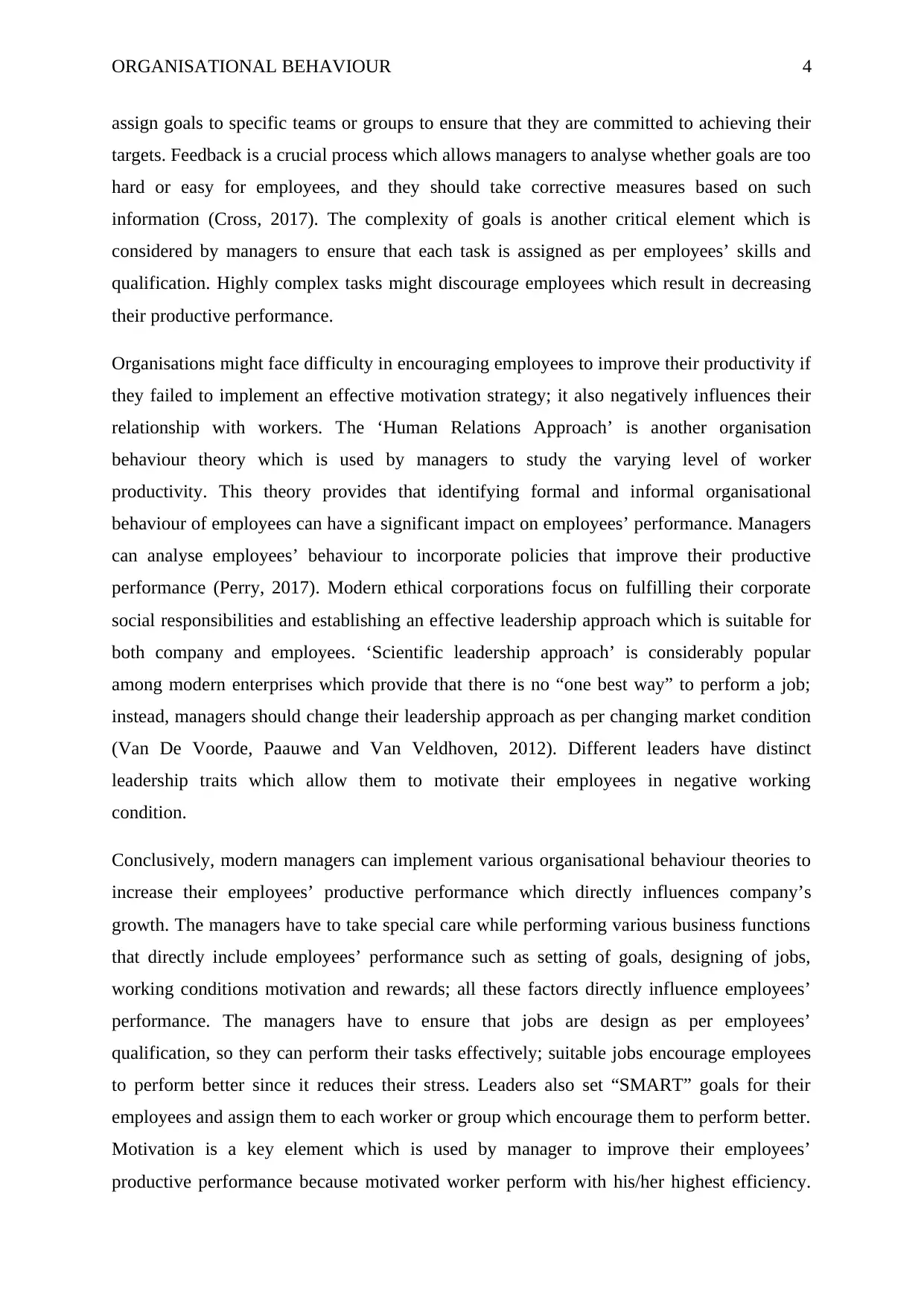
ORGANISATIONAL BEHAVIOUR 4
assign goals to specific teams or groups to ensure that they are committed to achieving their
targets. Feedback is a crucial process which allows managers to analyse whether goals are too
hard or easy for employees, and they should take corrective measures based on such
information (Cross, 2017). The complexity of goals is another critical element which is
considered by managers to ensure that each task is assigned as per employees’ skills and
qualification. Highly complex tasks might discourage employees which result in decreasing
their productive performance.
Organisations might face difficulty in encouraging employees to improve their productivity if
they failed to implement an effective motivation strategy; it also negatively influences their
relationship with workers. The ‘Human Relations Approach’ is another organisation
behaviour theory which is used by managers to study the varying level of worker
productivity. This theory provides that identifying formal and informal organisational
behaviour of employees can have a significant impact on employees’ performance. Managers
can analyse employees’ behaviour to incorporate policies that improve their productive
performance (Perry, 2017). Modern ethical corporations focus on fulfilling their corporate
social responsibilities and establishing an effective leadership approach which is suitable for
both company and employees. ‘Scientific leadership approach’ is considerably popular
among modern enterprises which provide that there is no “one best way” to perform a job;
instead, managers should change their leadership approach as per changing market condition
(Van De Voorde, Paauwe and Van Veldhoven, 2012). Different leaders have distinct
leadership traits which allow them to motivate their employees in negative working
condition.
Conclusively, modern managers can implement various organisational behaviour theories to
increase their employees’ productive performance which directly influences company’s
growth. The managers have to take special care while performing various business functions
that directly include employees’ performance such as setting of goals, designing of jobs,
working conditions motivation and rewards; all these factors directly influence employees’
performance. The managers have to ensure that jobs are design as per employees’
qualification, so they can perform their tasks effectively; suitable jobs encourage employees
to perform better since it reduces their stress. Leaders also set “SMART” goals for their
employees and assign them to each worker or group which encourage them to perform better.
Motivation is a key element which is used by manager to improve their employees’
productive performance because motivated worker perform with his/her highest efficiency.
assign goals to specific teams or groups to ensure that they are committed to achieving their
targets. Feedback is a crucial process which allows managers to analyse whether goals are too
hard or easy for employees, and they should take corrective measures based on such
information (Cross, 2017). The complexity of goals is another critical element which is
considered by managers to ensure that each task is assigned as per employees’ skills and
qualification. Highly complex tasks might discourage employees which result in decreasing
their productive performance.
Organisations might face difficulty in encouraging employees to improve their productivity if
they failed to implement an effective motivation strategy; it also negatively influences their
relationship with workers. The ‘Human Relations Approach’ is another organisation
behaviour theory which is used by managers to study the varying level of worker
productivity. This theory provides that identifying formal and informal organisational
behaviour of employees can have a significant impact on employees’ performance. Managers
can analyse employees’ behaviour to incorporate policies that improve their productive
performance (Perry, 2017). Modern ethical corporations focus on fulfilling their corporate
social responsibilities and establishing an effective leadership approach which is suitable for
both company and employees. ‘Scientific leadership approach’ is considerably popular
among modern enterprises which provide that there is no “one best way” to perform a job;
instead, managers should change their leadership approach as per changing market condition
(Van De Voorde, Paauwe and Van Veldhoven, 2012). Different leaders have distinct
leadership traits which allow them to motivate their employees in negative working
condition.
Conclusively, modern managers can implement various organisational behaviour theories to
increase their employees’ productive performance which directly influences company’s
growth. The managers have to take special care while performing various business functions
that directly include employees’ performance such as setting of goals, designing of jobs,
working conditions motivation and rewards; all these factors directly influence employees’
performance. The managers have to ensure that jobs are design as per employees’
qualification, so they can perform their tasks effectively; suitable jobs encourage employees
to perform better since it reduces their stress. Leaders also set “SMART” goals for their
employees and assign them to each worker or group which encourage them to perform better.
Motivation is a key element which is used by manager to improve their employees’
productive performance because motivated worker perform with his/her highest efficiency.
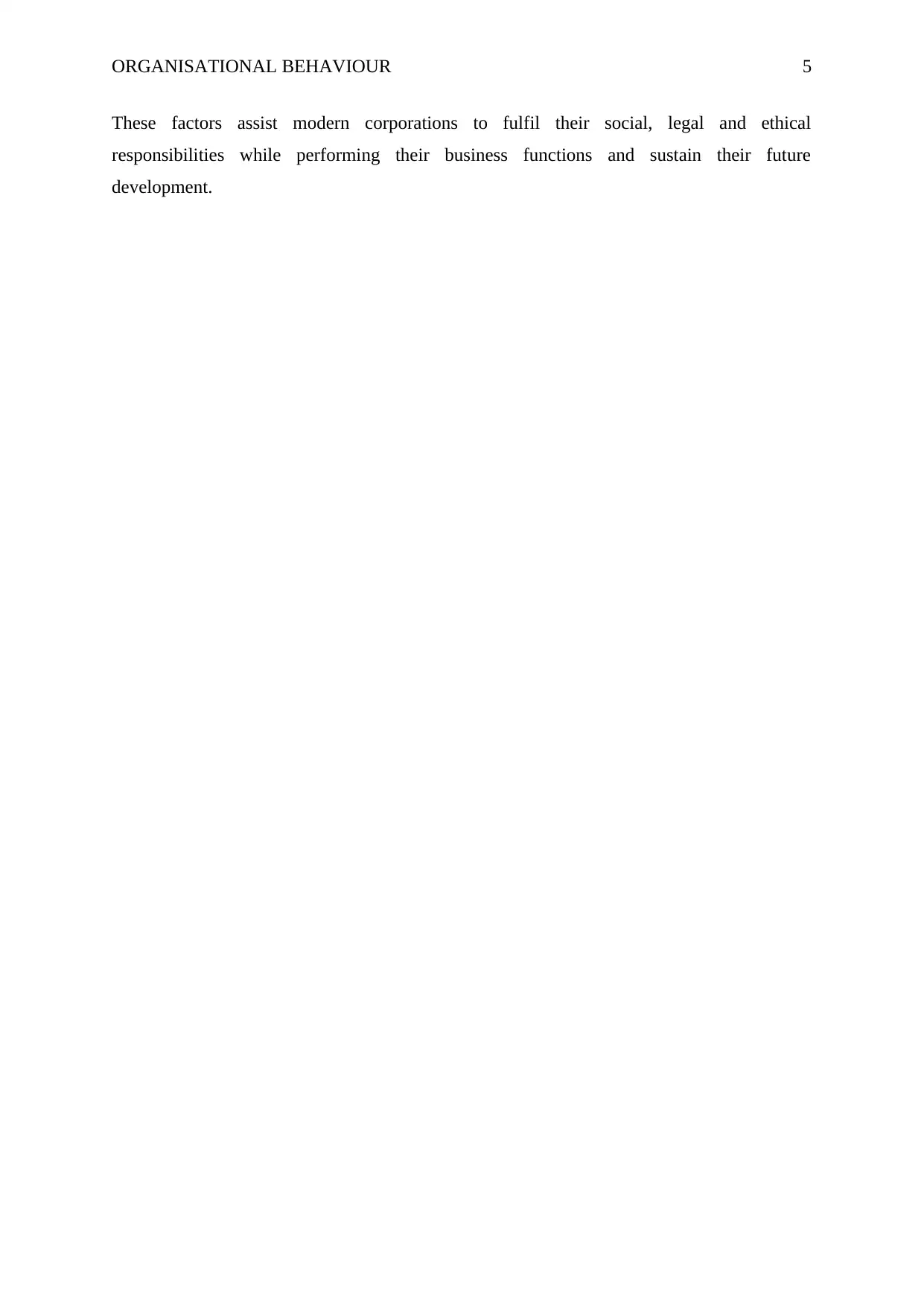
ORGANISATIONAL BEHAVIOUR 5
These factors assist modern corporations to fulfil their social, legal and ethical
responsibilities while performing their business functions and sustain their future
development.
These factors assist modern corporations to fulfil their social, legal and ethical
responsibilities while performing their business functions and sustain their future
development.
⊘ This is a preview!⊘
Do you want full access?
Subscribe today to unlock all pages.

Trusted by 1+ million students worldwide
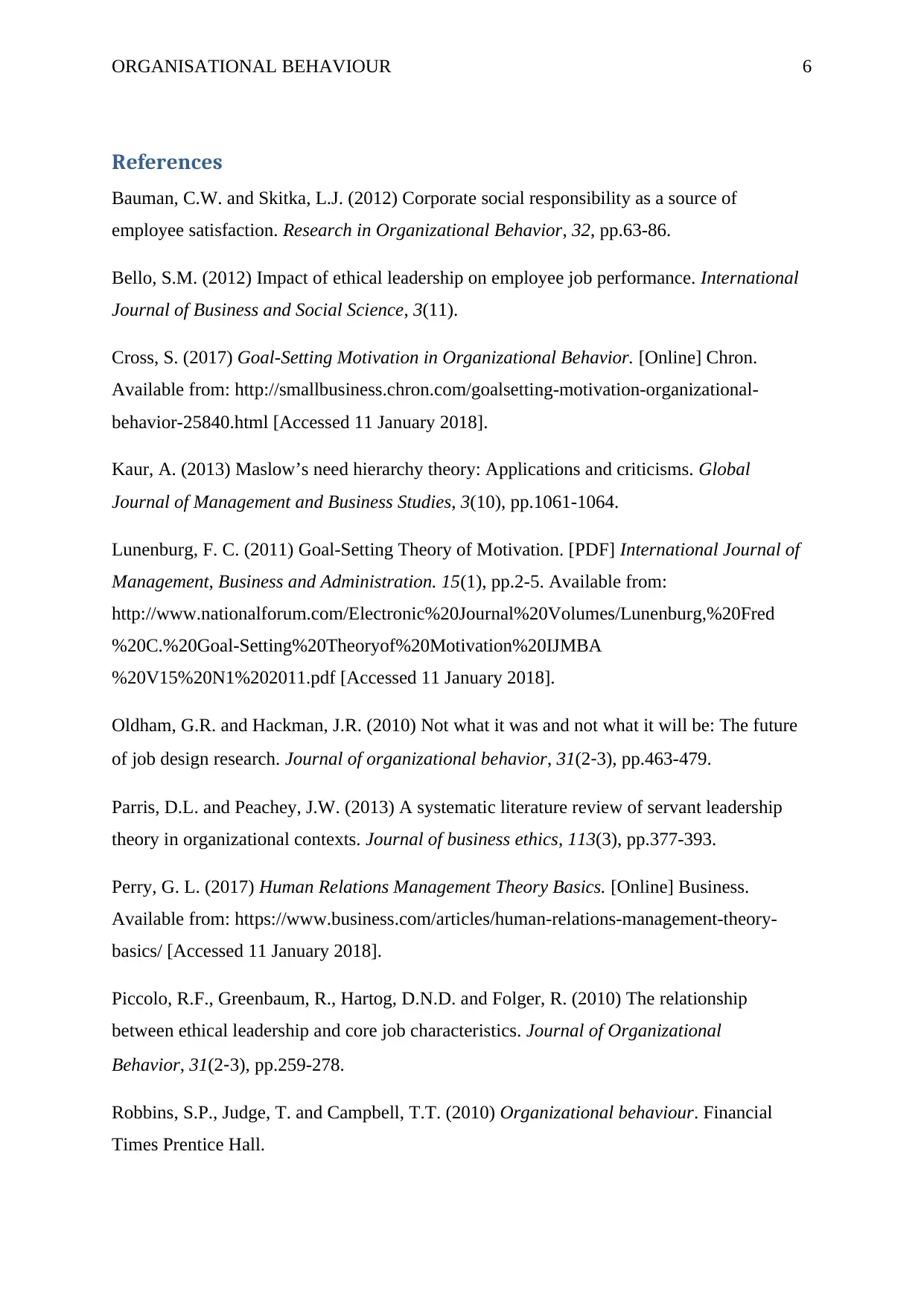
ORGANISATIONAL BEHAVIOUR 6
References
Bauman, C.W. and Skitka, L.J. (2012) Corporate social responsibility as a source of
employee satisfaction. Research in Organizational Behavior, 32, pp.63-86.
Bello, S.M. (2012) Impact of ethical leadership on employee job performance. International
Journal of Business and Social Science, 3(11).
Cross, S. (2017) Goal-Setting Motivation in Organizational Behavior. [Online] Chron.
Available from: http://smallbusiness.chron.com/goalsetting-motivation-organizational-
behavior-25840.html [Accessed 11 January 2018].
Kaur, A. (2013) Maslow’s need hierarchy theory: Applications and criticisms. Global
Journal of Management and Business Studies, 3(10), pp.1061-1064.
Lunenburg, F. C. (2011) Goal-Setting Theory of Motivation. [PDF] International Journal of
Management, Business and Administration. 15(1), pp.2-5. Available from:
http://www.nationalforum.com/Electronic%20Journal%20Volumes/Lunenburg,%20Fred
%20C.%20Goal-Setting%20Theoryof%20Motivation%20IJMBA
%20V15%20N1%202011.pdf [Accessed 11 January 2018].
Oldham, G.R. and Hackman, J.R. (2010) Not what it was and not what it will be: The future
of job design research. Journal of organizational behavior, 31(2‐3), pp.463-479.
Parris, D.L. and Peachey, J.W. (2013) A systematic literature review of servant leadership
theory in organizational contexts. Journal of business ethics, 113(3), pp.377-393.
Perry, G. L. (2017) Human Relations Management Theory Basics. [Online] Business.
Available from: https://www.business.com/articles/human-relations-management-theory-
basics/ [Accessed 11 January 2018].
Piccolo, R.F., Greenbaum, R., Hartog, D.N.D. and Folger, R. (2010) The relationship
between ethical leadership and core job characteristics. Journal of Organizational
Behavior, 31(2‐3), pp.259-278.
Robbins, S.P., Judge, T. and Campbell, T.T. (2010) Organizational behaviour. Financial
Times Prentice Hall.
References
Bauman, C.W. and Skitka, L.J. (2012) Corporate social responsibility as a source of
employee satisfaction. Research in Organizational Behavior, 32, pp.63-86.
Bello, S.M. (2012) Impact of ethical leadership on employee job performance. International
Journal of Business and Social Science, 3(11).
Cross, S. (2017) Goal-Setting Motivation in Organizational Behavior. [Online] Chron.
Available from: http://smallbusiness.chron.com/goalsetting-motivation-organizational-
behavior-25840.html [Accessed 11 January 2018].
Kaur, A. (2013) Maslow’s need hierarchy theory: Applications and criticisms. Global
Journal of Management and Business Studies, 3(10), pp.1061-1064.
Lunenburg, F. C. (2011) Goal-Setting Theory of Motivation. [PDF] International Journal of
Management, Business and Administration. 15(1), pp.2-5. Available from:
http://www.nationalforum.com/Electronic%20Journal%20Volumes/Lunenburg,%20Fred
%20C.%20Goal-Setting%20Theoryof%20Motivation%20IJMBA
%20V15%20N1%202011.pdf [Accessed 11 January 2018].
Oldham, G.R. and Hackman, J.R. (2010) Not what it was and not what it will be: The future
of job design research. Journal of organizational behavior, 31(2‐3), pp.463-479.
Parris, D.L. and Peachey, J.W. (2013) A systematic literature review of servant leadership
theory in organizational contexts. Journal of business ethics, 113(3), pp.377-393.
Perry, G. L. (2017) Human Relations Management Theory Basics. [Online] Business.
Available from: https://www.business.com/articles/human-relations-management-theory-
basics/ [Accessed 11 January 2018].
Piccolo, R.F., Greenbaum, R., Hartog, D.N.D. and Folger, R. (2010) The relationship
between ethical leadership and core job characteristics. Journal of Organizational
Behavior, 31(2‐3), pp.259-278.
Robbins, S.P., Judge, T. and Campbell, T.T. (2010) Organizational behaviour. Financial
Times Prentice Hall.
Paraphrase This Document
Need a fresh take? Get an instant paraphrase of this document with our AI Paraphraser
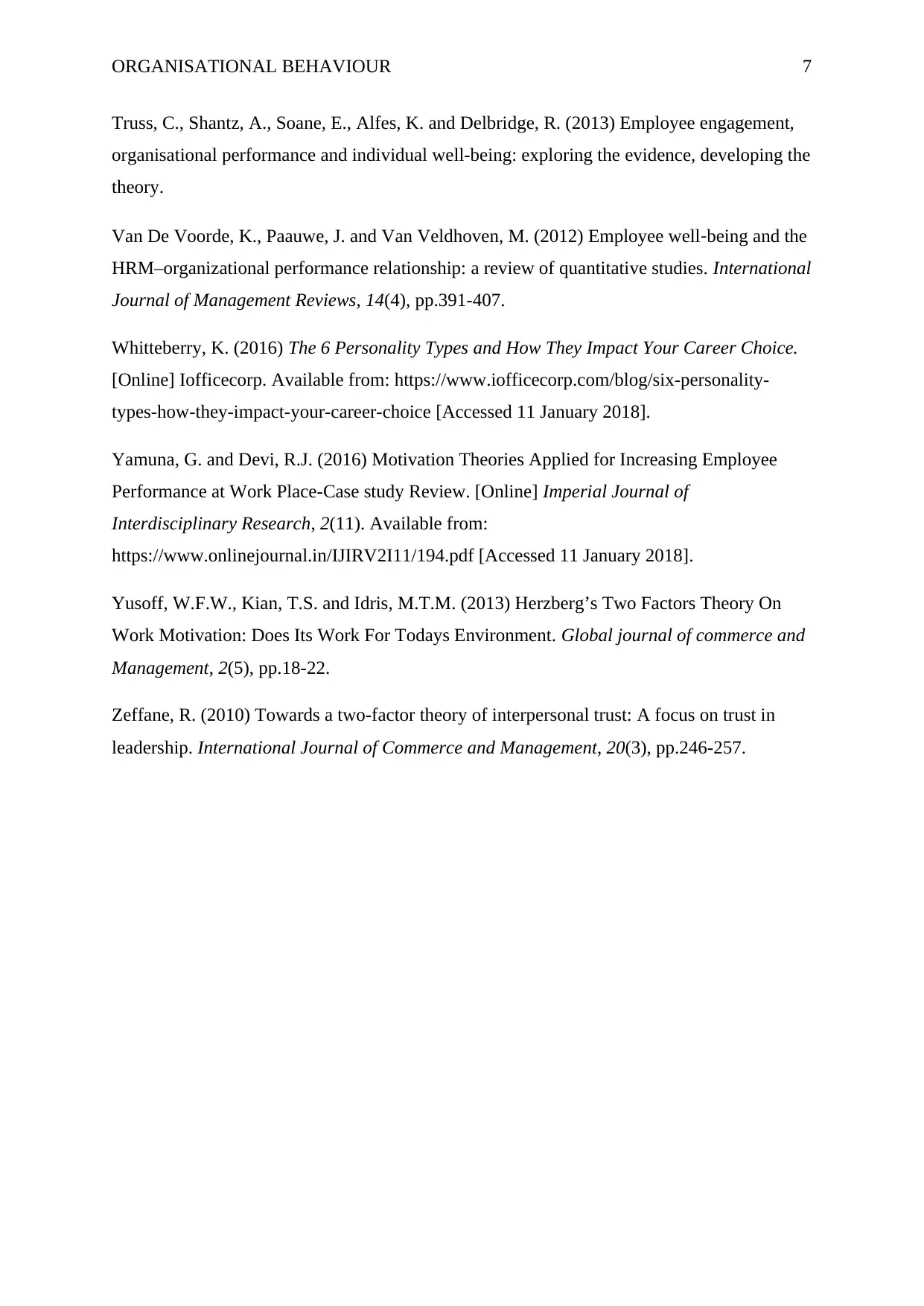
ORGANISATIONAL BEHAVIOUR 7
Truss, C., Shantz, A., Soane, E., Alfes, K. and Delbridge, R. (2013) Employee engagement,
organisational performance and individual well-being: exploring the evidence, developing the
theory.
Van De Voorde, K., Paauwe, J. and Van Veldhoven, M. (2012) Employee well‐being and the
HRM–organizational performance relationship: a review of quantitative studies. International
Journal of Management Reviews, 14(4), pp.391-407.
Whitteberry, K. (2016) The 6 Personality Types and How They Impact Your Career Choice.
[Online] Iofficecorp. Available from: https://www.iofficecorp.com/blog/six-personality-
types-how-they-impact-your-career-choice [Accessed 11 January 2018].
Yamuna, G. and Devi, R.J. (2016) Motivation Theories Applied for Increasing Employee
Performance at Work Place-Case study Review. [Online] Imperial Journal of
Interdisciplinary Research, 2(11). Available from:
https://www.onlinejournal.in/IJIRV2I11/194.pdf [Accessed 11 January 2018].
Yusoff, W.F.W., Kian, T.S. and Idris, M.T.M. (2013) Herzberg’s Two Factors Theory On
Work Motivation: Does Its Work For Todays Environment. Global journal of commerce and
Management, 2(5), pp.18-22.
Zeffane, R. (2010) Towards a two-factor theory of interpersonal trust: A focus on trust in
leadership. International Journal of Commerce and Management, 20(3), pp.246-257.
Truss, C., Shantz, A., Soane, E., Alfes, K. and Delbridge, R. (2013) Employee engagement,
organisational performance and individual well-being: exploring the evidence, developing the
theory.
Van De Voorde, K., Paauwe, J. and Van Veldhoven, M. (2012) Employee well‐being and the
HRM–organizational performance relationship: a review of quantitative studies. International
Journal of Management Reviews, 14(4), pp.391-407.
Whitteberry, K. (2016) The 6 Personality Types and How They Impact Your Career Choice.
[Online] Iofficecorp. Available from: https://www.iofficecorp.com/blog/six-personality-
types-how-they-impact-your-career-choice [Accessed 11 January 2018].
Yamuna, G. and Devi, R.J. (2016) Motivation Theories Applied for Increasing Employee
Performance at Work Place-Case study Review. [Online] Imperial Journal of
Interdisciplinary Research, 2(11). Available from:
https://www.onlinejournal.in/IJIRV2I11/194.pdf [Accessed 11 January 2018].
Yusoff, W.F.W., Kian, T.S. and Idris, M.T.M. (2013) Herzberg’s Two Factors Theory On
Work Motivation: Does Its Work For Todays Environment. Global journal of commerce and
Management, 2(5), pp.18-22.
Zeffane, R. (2010) Towards a two-factor theory of interpersonal trust: A focus on trust in
leadership. International Journal of Commerce and Management, 20(3), pp.246-257.
1 out of 8
Related Documents
Your All-in-One AI-Powered Toolkit for Academic Success.
+13062052269
info@desklib.com
Available 24*7 on WhatsApp / Email
![[object Object]](/_next/static/media/star-bottom.7253800d.svg)
Unlock your academic potential
Copyright © 2020–2025 A2Z Services. All Rights Reserved. Developed and managed by ZUCOL.




